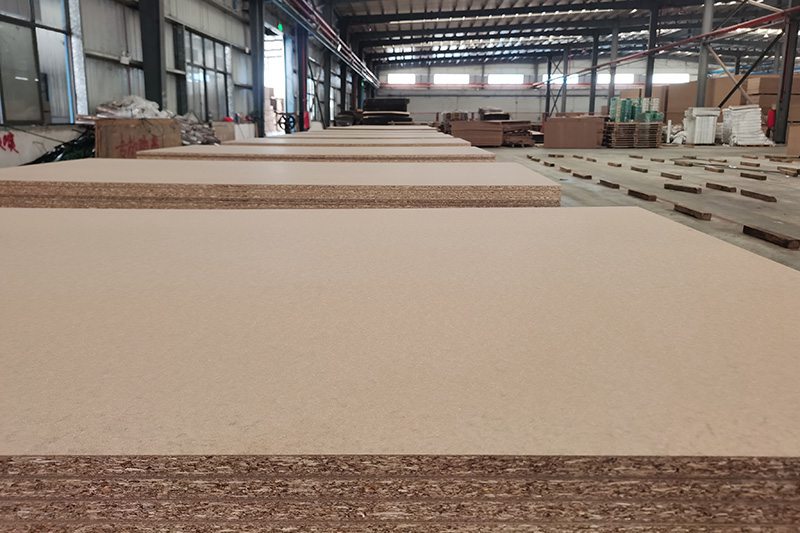Is MDF the Same as Particle Board?
At first glance, MDF (Medium-Density Fiberboard) and Particle Board (chipboard) look alike—both are smooth, uniform wood-based panels used in furniture, cabinetry, and interior decoration. But they’re not the same. The key difference lies in what they’re made of, how they’re pressed, and how they perform under mechanical stress, moisture, and machining. Understanding their distinctions helps you choose the right material for your design or manufacturing project.
1) Composition and Manufacturing Process
particle board is made from small wood chips, shavings, and sawdust bound together with resin and pressed into flat sheets under heat. The particles vary in size, creating a coarse inner core and smoother outer layers. Its structure resembles compacted granules.
MDF, by contrast, is made from wood fibers—finer than sawdust—mixed with resin and wax, then pressed under higher temperature and pressure. The result is a dense, homogeneous material with no visible particles and a consistent texture throughout.
| Feature | Particle Board | MDF (Medium-Density Fiberboard) |
|---|---|---|
| Raw material | Wood chips and shavings | Fine wood fibers |
| Resin type | Usually urea-formaldehyde | Urea- or melamine-formaldehyde with wax additives |
| Surface texture | Smooth but slightly granular | Extremely smooth and fine |
| Internal structure | Layered (coarse core, fine faces) | Uniform and dense throughout |
| Manufacturing pressure | Moderate | Higher (denser, heavier result) |
What it means: MDF’s finer fibers give it a higher density and smoother surface ideal for painting or intricate routing. Particle board’s coarser texture makes it lighter and cheaper but less strong and less precise for detailed machining.
2) Strength, Durability, and Workability
When comparing structural performance, both materials have advantages and limits depending on the use case.
Strength and Structural Integrity
MDF is denser (around 700–800 kg/m³) and generally stronger than particle board (around 620–680 kg/m³). It has better screw-holding power, especially on the faces, and higher bending strength. This makes MDF suitable for cabinet doors, decorative moldings, and furniture panels that need rigidity and machining detail.
Particle board, though weaker, can still handle moderate loads when supported properly. It performs well in flat-pack furniture, shelving, and interior panels that are laminated or veneered and not exposed to high stress.
Moisture Resistance
Both materials are sensitive to water, but MDF tends to swell less severely if moisture-resistant (MR) versions are used.
Standard particle board will swell and lose strength quickly when wet because of its coarse, porous core.
For damp environments like kitchens or bathrooms, always choose MR MDF or MR particle board, both of which contain moisture-inhibiting resin.
Workability
MDF cuts and machines beautifully. Its fine fibers allow for smooth edges, routed profiles, and paintable finishes without grain telegraphing.
Particle board chips more easily when cut or drilled, especially at the edges. It’s better suited to straight cuts, laminated tops, or hidden panels rather than decorative profiles.
Both materials create fine dust; use dust extraction and protective gear when machining.
| Property | MDF | Particle Board |
|---|---|---|
| Bending strength | Higher (≈15–25 MPa) | Moderate (≈11–16 MPa) |
| Stiffness (MOE) | ≈2.5–3.5 GPa | ≈1.8–2.6 GPa |
| Screw holding (face) | Strong | Moderate |
| Screw holding (edge) | Better than PB but weaker than plywood | Weak—needs confirmat or cam fasteners |
| Moisture resistance (standard grade) | Moderate | Poor |
| Paint/finish quality | Excellent | Fair to good under laminate |
| Machining detail | Excellent (fine routing possible) | Limited (chips at edges) |
3) Applications: Where Each Material Excels
Both boards occupy different niches in woodworking and furniture manufacturing. The best choice depends on function, finish, and cost.
MDF – Best For:
Painted furniture and cabinetry
MDF’s smooth surface takes primer and paint evenly without grain lines or texture showing through. It’s perfect for modern flat-panel cabinet doors and decorative wall panels.Decorative molding and profiling
Its fiber structure allows fine routing—ideal for crown moldings, door frames, and ornate trim.Speaker boxes and acoustics
MDF’s density provides excellent sound damping and stability, making it popular for speaker enclosures.Interior doors and display fixtures
Its rigidity and flatness keep surfaces true, reducing warping.
Particle Board – Best For:
Laminate furniture cores
When covered with melamine or veneer, particle board provides a flat, economical core for desks, wardrobes, and countertops.Cabinet carcasses and shelving
In kitchens and offices, particle board serves as the hidden structure behind decorative fronts, reducing weight and cost.Floor underlayment and interior panels
Thick, high-density particle board can serve as subflooring or wall backing under dry conditions.Disposable or budget furniture
Flat-pack furniture uses particle board for its affordability and ease of mass production.
Summary Table: Choosing Between MDF and Particle Board
| Situation | Recommended Material | Reason |
|---|---|---|
| Painted finish required | MDF | Ultra-smooth surface, no grain telegraph |
| Laminated or veneered finish | Particle board | Cost-effective and dimensionally stable |
| Curved or routed edges | MDF | Machines cleanly with fine detail |
| Hidden interior panels | Particle board | Lightweight and economical |
| Moist areas (kitchens, baths) | MR MDF or MR PB | Moisture-resistant resin extends life |
| Heavy load shelving | MDF (thick) or plywood | Stiffer and stronger than particle board |
4) Cost, Sustainability, and Finishing
Cost
Particle board is generally cheaper due to its simpler production and lower density. MDF costs slightly more because it requires finer wood fibers, higher pressure, and additional finishing potential. However, both remain far more affordable than solid wood or plywood.
Environmental Considerations
Both materials are efficient uses of wood waste, turning sawdust and offcuts into valuable boards. They are often made with a high percentage of recycled fiber. Formaldehyde emissions are a concern in lower-quality boards, but E0/E1-grade products meet modern low-emission standards. MDF tends to use slightly higher resin content, but eco-certified MDF is widely available.
Surface Finishing
MDF can be painted, laminated, or veneered directly. It sands easily and produces crisp edges.
Particle board almost always needs a laminate or veneer layer to hide the coarse surface and improve durability. Without covering, it can chip or absorb moisture rapidly.
Both can be edge-banded with PVC or veneer tape to protect exposed edges.
Conclusion
MDF and particle board share a purpose—cost-effective, flat wood panels—but they are structurally and functionally distinct.
MDF is denser, smoother, stronger, and more versatile for painting and machining. It’s ideal for decorative and precision applications.
Particle board is lighter, cheaper, and excellent as a laminated substrate where surfaces are not directly exposed.
Choosing between them depends on how the panel will be finished, where it will be installed, and how much load it must bear. For visible, detailed, or painted surfaces, go MDF. For interior carcasses, laminated furniture, and cost-sensitive projects, particle board remains a practical and dependable option.
In short: MDF and particle board aren’t the same—but they complement each other in modern furniture manufacturing, combining affordability with performance when used wisely.
Previous: Is Particle Board Toxic?


